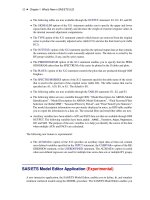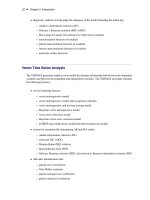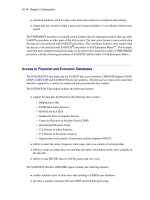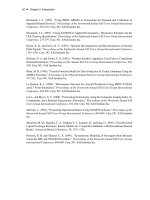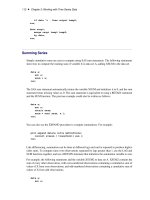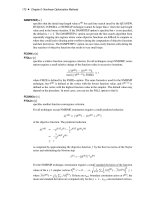SAS/ETS 9.22 User''''s Guide 8 pptx
Bạn đang xem bản rút gọn của tài liệu. Xem và tải ngay bản đầy đủ của tài liệu tại đây (229.03 KB, 10 trang )
62 ✦ Chapter 2: Introduction
Hisnanick, J. J. (1992), “Using PROC ARIMA in Forecasting the Demand and Utilization of
Inpatient Hospital Services,” Proceedings of the Seventeenth Annual SAS Users Group International
Conference, 383-391. Cary, NC: SAS Institute Inc.
Hisnanick, J. J. (1993), “Using SAS/ETS in Applied Econometrics: Parameters Estimates for the
CES-Translog Specification,” Proceedings of the Eighteenth Annual SAS Users Group International
Conference, 275-279. Cary, NC: SAS Institute Inc.
Hoyer, K. K. and Gross, K. C. (1993), “Spectral Decomposition and Reconstruction of Nuclear
Plant Signals,” Proceedings of the Eighteenth Annual SAS Users Group International Conference,
1153-1158. Cary, NC: SAS Institute Inc.
Keshani, D. A. and Taylor, T. N. (1992), “Weather Sensitive Appliance Load Curves; Conditional
Demand Estimation,” Proceedings of the Annual SAS Users Group International Conference, 422-
430. Cary, NC: SAS Institute Inc.
Khan, M. H. (1990), “Transfer Function Model for Gloss Prediction of Coated Aluminum Using the
ARIMA Procedure,” Proceedings of the Fifteenth Annual SAS Users Group International Conference,
517-522. Cary, NC: SAS Institute Inc.
Le Bouton, K. J. (1989), “Performance Function for Aircraft Production Using PROC SYSLIN
and L
2
Norm Estimation,” Proceedings of the Fourteenth Annual SAS Users Group International
Conference, 424-426. Cary, NC: SAS Institute Inc.
Lin, L. and Myers, S. C. (1988), “Forecasting the Economy using the Composite Leading Index, Its
Components, and a Rational Expectations Alternative,” Proceedings of the Thirteenth Annual SAS
Users Group International Conference, 181-186. Cary, NC: SAS Institute Inc.
McCarty, L. (1994), “Forecasting Operational Indices Using SAS/ETS Software,” Proceedings of the
Nineteenth Annual SAS Users Group International Conference, 844-848. Cary, NC: SAS Institute
Inc.
Morelock, M. M., Pargellis, C. A., Graham, E. T., Lamarre, D., and Jung, G. (1995), “Time-Resolved
Ligand Exchange Reactions: Kinetic Models for Competitive Inhibitors with Recombinant Human
Renin,” Journal of Medical Chemistry, 38, 1751–1761.
Parresol, B. R. and Thomas, C. E. (1991), “Econometric Modeling of Sweetgum Stem Biomass
Using the IML and SYSLIN Procedures,” Proceedings of the Sixteenth Annual SAS Users Group
International Conference, 694-699. Cary, NC: SAS Institute Inc.
Chapter 3
Working with Time Series Data
Contents
Overview . . . . . . . . . . . . . . . . . . . . . . . . . . . . . . . . . . . . . . . 64
Time Series and SAS Data Sets . . . . . . . . . . . . . . . . . . . . . . . . . . . . 65
Introduction . . . . . . . . . . . . . . . . . . . . . . . . . . . . . . . . . . 65
Reading a Simple Time Series . . . . . . . . . . . . . . . . . . . . . . . . . 66
Dating Observations . . . . . . . . . . . . . . . . . . . . . . . . . . . . . . . . . . 67
SAS Date, Datetime, and Time Values . . . . . . . . . . . . . . . . . . . . . 68
Reading Date and Datetime Values with Informats . . . . . . . . . . . . . . 69
Formatting Date and Datetime Values . . . . . . . . . . . . . . . . . . . . . 70
The Variables DATE and DATETIME . . . . . . . . . . . . . . . . . . . . . . 71
Sorting by Time . . . . . . . . . . . . . . . . . . . . . . . . . . . . . . . . 72
Subsetting Data and Selecting Observations . . . . . . . . . . . . . . . . . . . . . 73
Subsetting SAS Data Sets . . . . . . . . . . . . . . . . . . . . . . . . . . . 73
Using the WHERE Statement with SAS Procedures . . . . . . . . . . . . . 74
Using SAS Data Set Options . . . . . . . . . . . . . . . . . . . . . . . . . . 75
Storing Time Series in a SAS Data Set . . . . . . . . . . . . . . . . . . . . . . . . 75
Standard Form of a Time Series Data Set . . . . . . . . . . . . . . . . . . . 76
Several Series with Different Ranges . . . . . . . . . . . . . . . . . . . . . . 77
Missing Values and Omitted Observations . . . . . . . . . . . . . . . . . . 78
Cross-Sectional Dimensions and BY Groups . . . . . . . . . . . . . . . . . 79
Interleaved Time Series . . . . . . . . . . . . . . . . . . . . . . . . . . . . 80
Output Data Sets of SAS/ETS Procedures . . . . . . . . . . . . . . . . . . . 82
Time Series Periodicity and Time Intervals . . . . . . . . . . . . . . . . . . . . . 84
Specifying Time Intervals . . . . . . . . . . . . . . . . . . . . . . . . . . . 84
Using Intervals with SAS/ETS Procedures . . . . . . . . . . . . . . . . . . 85
Time Intervals, the Time Series Forecasting System, and the Time Series Viewer
85
Plotting Time Series . . . . . . . . . . . . . . . . . . . . . . . . . . . . . . . . . 86
Using the Time Series Viewer . . . . . . . . . . . . . . . . . . . . . . . . . 86
Using PROC SGPLOT . . . . . . . . . . . . . . . . . . . . . . . . . . . . . 86
Using PROC PLOT . . . . . . . . . . . . . . . . . . . . . . . . . . . . . . . 91
Using PROC TIMEPLOT . . . . . . . . . . . . . . . . . . . . . . . . . . . 92
Using PROC GPLOT . . . . . . . . . . . . . . . . . . . . . . . . . . . . . 93
Calendar and Time Functions . . . . . . . . . . . . . . . . . . . . . . . . . . . . . 94
Computing Dates from Calendar Variables . . . . . . . . . . . . . . . . . . 95
Computing Calendar Variables from Dates . . . . . . . . . . . . . . . . . . 95
64 ✦ Chapter 3: Working with Time Series Data
Converting between Date, Datetime, and Time Values . . . . . . . . . . . . 96
Computing Datetime Values . . . . . . . . . . . . . . . . . . . . . . . . . . 96
Computing Calendar and Time Variables . . . . . . . . . . . . . . . . . . . . 97
Interval Functions INTNX and INTCK . . . . . . . . . . . . . . . . . . . . . . . . 97
Incrementing Dates by Intervals . . . . . . . . . . . . . . . . . . . . . . . . 98
Alignment of SAS Dates . . . . . . . . . . . . . . . . . . . . . . . . . . . . 99
Computing the Width of a Time Interval . . . . . . . . . . . . . . . . . . . 100
Computing the Ceiling of an Interval . . . . . . . . . . . . . . . . . . . . . . 101
Counting Time Intervals . . . . . . . . . . . . . . . . . . . . . . . . . . . . . 101
Checking Data Periodicity . . . . . . . . . . . . . . . . . . . . . . . . . . . 102
Filling In Omitted Observations in a Time Series Data Set . . . . . . . . . . 102
Using Interval Functions for Calendar Calculations . . . . . . . . . . . . . . 103
Lags, Leads, Differences, and Summations . . . . . . . . . . . . . . . . . . . . . 104
The LAG and DIF Functions . . . . . . . . . . . . . . . . . . . . . . . . . . 104
Multiperiod Lags and Higher-Order Differencing . . . . . . . . . . . . . . . 108
Percent Change Calculations . . . . . . . . . . . . . . . . . . . . . . . . . . 109
Leading Series . . . . . . . . . . . . . . . . . . . . . . . . . . . . . . . . . . 111
Summing Series . . . . . . . . . . . . . . . . . . . . . . . . . . . . . . . . 112
Transforming Time Series . . . . . . . . . . . . . . . . . . . . . . . . . . . . . . 113
Log Transformation . . . . . . . . . . . . . . . . . . . . . . . . . . . . . . 114
Other Transformations . . . . . . . . . . . . . . . . . . . . . . . . . . . . . 115
The EXPAND Procedure and Data Transformations . . . . . . . . . . . . . 116
Manipulating Time Series Data Sets . . . . . . . . . . . . . . . . . . . . . . . . . 116
Splitting and Merging Data Sets . . . . . . . . . . . . . . . . . . . . . . . . 116
Transposing Data Sets . . . . . . . . . . . . . . . . . . . . . . . . . . . . . . 117
Time Series Interpolation . . . . . . . . . . . . . . . . . . . . . . . . . . . . . . . . 121
Interpolating Missing Values . . . . . . . . . . . . . . . . . . . . . . . . . . 122
Interpolating to a Higher or Lower Frequency . . . . . . . . . . . . . . . . . 122
Interpolating between Stocks and Flows, Levels and Rates . . . . . . . . . . 123
Reading Time Series Data . . . . . . . . . . . . . . . . . . . . . . . . . . . . . . 123
Reading a Simple List of Values . . . . . . . . . . . . . . . . . . . . . . . . 124
Reading Fully Described Time Series in Transposed Form . . . . . . . . . . 124
Overview
This chapter discusses working with time series data in the SAS System. The following topics are
included:
dating time series and working with SAS date and datetime values
subsetting data and selecting observations
Time Series and SAS Data Sets ✦ 65
storing time series data in SAS data sets
specifying time series periodicity and time intervals
plotting time series
using calendar and time interval functions
computing lags and other functions across time
transforming time series
transposing time series data sets
interpolating time series
reading time series data recorded in different ways
In general, this chapter focuses on using features of the SAS programming language and not on
features of SAS/ETS software. However, since SAS/ETS procedures are used to analyze time series,
understanding how to use the SAS programming language to work with time series data is important
for the effective use of SAS/ETS software.
You do not need to read this chapter to use SAS/ETS procedures. If you are already familiar with
SAS programming you might want to skip this chapter, or you can refer to sections of this chapter
for help on specific time series data processing questions.
Time Series and SAS Data Sets
Introduction
To analyze data with the SAS System, data values must be stored in a SAS data set. A SAS data set
is a matrix (or table) of data values organized into variables and observations.
The variables in a SAS data set label the columns of the data matrix, and the observations in a SAS
data set are the rows of the data matrix. You can also think of a SAS data set as a kind of file, with
the observations representing records in the file and the variables representing fields in the records.
(See SAS Language Reference: Concepts for more information about SAS data sets.)
Usually, each observation represents the measurement of one or more variables for the individual
subject or item observed. Often, the values of some of the variables in the data set are used to
identify the individual subjects or items that the observations measure. These identifying variables
are referred to as ID variables.
For many kinds of statistical analysis, only relationships among the variables are of interest, and the
identity of the observations does not matter. ID variables might not be relevant in such a case.
66 ✦ Chapter 3: Working with Time Series Data
However, for time series data the identity and order of the observations are crucial. A time series is a
set of observations made at a succession of equally spaced points in time.
For example, if the data are monthly sales of a company’s product, the variable measured is sales
of the product and the unit observed is the operation of the company during each month. These
observations can be identified by year and month. If the data are quarterly gross national product,
the variable measured is final goods production and the unit observed is the economy during each
quarter. These observations can be identified by year and quarter.
For time series data, the observations are identified and related to each other by their position in time.
Since SAS does not assume any particular structure to the observations in a SAS data set, there are
some special considerations needed when storing time series in a SAS data set.
The main considerations are how to associate dates with the observations and how to structure the
data set so that SAS/ETS procedures and other SAS procedures recognize the observations of the
data set as constituting time series. These issues are discussed in following sections.
Reading a Simple Time Series
Time series data can be recorded in many different ways. The section “Reading Time Series Data”
on page 123 discusses some of the possibilities. The example below shows a simple case.
The following SAS statements read monthly values of the U.S. Consumer Price Index for June 1990
through July 1991. The data set USCPI is shown in Figure 3.1.
data uscpi;
input year month cpi;
datalines;
1990 6 129.9
1990 7 130.4
more lines
proc print data=uscpi;
run;
Dating Observations ✦ 67
Figure 3.1 Time Series Data
Obs year month cpi
1 1990 6 129.9
2 1990 7 130.4
3 1990 8 131.6
4 1990 9 132.7
5 1990 10 133.5
6 1990 11 133.8
7 1990 12 133.8
8 1991 1 134.6
9 1991 2 134.8
10 1991 3 135.0
11 1991 4 135.2
12 1991 5 135.6
13 1991 6 136.0
14 1991 7 136.2
When a time series is stored in the manner shown by this example, the terms series and variable can
be used interchangeably. There is one observation per row and one series/variable per column.
Dating Observations
The SAS System supports special date, datetime, and time values, which make it easy to represent
dates, perform calendar calculations, and identify the time period of observations in a data set.
The preceding example uses the ID variables YEAR and MONTH to identify the time periods of the
observations. For a quarterly data set, you might use YEAR and QTR as ID variables. A daily data
set might have the ID variables YEAR, MONTH, and DAY. Clearly, it would be more convenient to
have a single ID variable that could be used to identify the time period of observations, regardless of
their frequency.
The following section, “SAS Date, Datetime, and Time Values” on page 68, discusses how the SAS
System represents dates and times internally and how to specify date, datetime, and time values
in a SAS program. The section “Reading Date and Datetime Values with Informats” on page 69
discusses how to read in date and time values from data records and how to control the display of
date and datetime values in SAS output. Later sections discuss other issues concerning date and
datetime values, specifying time intervals, data periodicity, and calendar calculations.
SAS date and datetime values and the other features discussed in the following sections are also
described in SAS Language Reference: Dictionary. Reference documentation on these features is
also provided in Chapter 4, “Date Intervals, Formats, and Functions.”
68 ✦ Chapter 3: Working with Time Series Data
SAS Date, Datetime, and Time Values
SAS Date Values
SAS software represents dates as the number of days since a reference date. The reference date, or
date zero, used for SAS date values is 1 January 1960. For example, 3 February 1960 is represented
by SAS as 33. The SAS date for 17 October 1991 is 11612.
SAS software correctly represents dates from the year 1582 to the year 20,000.
Dates represented in this way are called SAS date values. Any numeric variable in a SAS data set
whose values represent dates in this way is called a SAS date variable.
Representing dates as the number of days from a reference date makes it easy for the computer
to store them and perform calendar calculations, but these numbers are not meaningful to users.
However, you never have to use SAS date values directly, since SAS automatically converts between
this internal representation and ordinary ways of expressing dates, provided that you indicate the
format with which you want the date values to be displayed. (Formatting of date values is explained
in the section “Formatting Date and Datetime Values” on page 70.)
Century of Dates Represented with Two-Digit Year Values
SAS software informats, functions, and formats can process dates that are represented with two-
digit year values. The century assumed for a two-digit year value can be controlled with the
YEARCUTOFF=
option in the OPTIONS statement. The YEARCUTOFF= system option controls
how dates with two-digit year values are interpreted by specifying the first year of a 100-year span.
The default value for the YEARCUTOFF= option is 1920. Thus by default the year ‘17’ is interpreted
as 2017, while the year ‘25’ is interpreted as 1925. (See SAS Language Reference: Dictionary for
more information about YEARCUTOFF=.)
SAS Date Constants
SAS date values are written in a SAS program by placing the dates in single quotes followed by a D.
The date is represented by the day of the month, the three letter abbreviation of the month name, and
the year.
For example, SAS reads the value ‘17OCT1991’D the same as 11612, the SAS date value for 17
October 1991. Thus, the following SAS statements print DATE=11612:
data _null_;
date = '17oct1991'd;
put date=;
run;
The year value can be given with two or four digits, so ‘17OCT91’D is the same as ‘17OCT1991’D.
Reading Date and Datetime Values with Informats ✦ 69
SAS Datetime Values and Datetime Constants
To represent both the time of day and the date, SAS uses datetime values. SAS datetime values
represent the date and time as the number of seconds the time is from a reference time. The reference
time, or time zero, used for SAS datetime values is midnight, 1 January 1960. Thus, for example, the
SAS datetime value for 17 October 1991 at 2:45 in the afternoon is 1003329900.
To specify datetime constants in a SAS program, write the date and time in single quotes followed
by DT. To write the date and time in a SAS datetime constant, write the date part using the same
syntax as for date constants, and follow the date part with the hours, the minutes, and the seconds,
separating the parts with colons. The seconds are optional.
For example, in a SAS program you would write 17 October 1991 at 2:45 in the afternoon as
‘17OCT91:14:45’DT. SAS reads this as 1003329900. Table 3.1 shows some other examples of
datetime constants.
Table 3.1 Examples of Datetime Constants
Datetime Constant Time
‘17OCT1991:14:45:32’DT 32 seconds past 2:45 p.m., 17 October 1991
‘17OCT1991:12:5’DT 12:05 p.m., 17 October 1991
‘17OCT1991:2:0’DT 2:00 a.m., 17 October 1991
‘17OCT1991:0:0’DT midnight, 17 October 1991
SAS Time Values
The SAS System also supports time values. SAS time values are just like datetime values, except
that the date part is not given. To write a time value in a SAS program, write the time the same as for
a datetime constant, but use T instead of DT. For example, 2:45:32 p.m. is written ‘14:45:32’T. Time
values are represented by a number of seconds since midnight, so SAS reads ‘14:45:32’T as 53132.
SAS time values are not very useful for identifying time series, since usually both the date and the
time of day are needed. Time values are not discussed further in this book.
Reading Date and Datetime Values with Informats
SAS provides a selection of informats for reading SAS date and datetime values from date and time
values recorded in ordinary notations.
A SAS informat is an instruction that converts the values from a character-string representation into
the internal numerical value of a SAS variable. Date informats convert dates from ordinary notations
used to enter them to SAS date values; datetime informats convert date and time from ordinary
notation to SAS datetime values.
For example, the following SAS statements read monthly values of the U.S. Consumer Price Index.
Since the data are monthly, you could identify the date with the variables YEAR and MONTH, as in
70 ✦ Chapter 3: Working with Time Series Data
the previous example. Instead, in this example the time periods are coded as a three-letter month
abbreviation followed by the year. The informat MONYY. is used to read month-year dates coded
this way and to express them as SAS date values for the first day of the month, as follows:
data uscpi;
input date : monyy7. cpi;
format date monyy7.;
label cpi = "US Consumer Price Index";
datalines;
jun1990 129.9
jul1990 130.4
more lines
The SAS System provides informats for most common notations for dates and times. See Chapter 4
for more information about the date and datetime informats available.
Formatting Date and Datetime Values
SAS provides formats to convert the internal representation of date and datetime values used by SAS
to ordinary notations for dates and times. Several different formats are available for displaying dates
and datetime values in most of the commonly used notations.
A SAS format is an instruction that converts the internal numerical value of a SAS variable to a
character string that can be printed or displayed. Date formats convert SAS date values to a readable
form; datetime formats convert SAS datetime values to a readable form.
In the preceding example, the variable DATE was set to the SAS date value for the first day of the
month for each observation. If the data set USCPI were printed or otherwise displayed, the values
shown for DATE would be the number of days since 1 January 1960. (See the “DATE with no format”
column in Figure 3.2.) To display date values appropriately, use the FORMAT statement.
The following example processes the data set USCPI to make several copies of the variable DATE
and uses a FORMAT statement to give different formats to these copies. The format cases shown are
the MONYY7. format (for the DATE variable), the DATE9. format (for the DATE1 variable), and
no format (for the DATE0 variable). The PROC PRINT output in Figure 3.2 shows the effect of the
different formats on how the date values are printed.
data fmttest;
set uscpi;
date0 = date;
date1 = date;
label date = "DATE with MONYY7. format"
date1 = "DATE with DATE9. format"
date0 = "DATE with no format";
format date monyy7. date1 date9.;
run;
proc print data=fmttest label;
The Variables DATE and DATETIME ✦ 71
run;
Figure 3.2 SAS Date Values Printed with Different Formats
US
DATE with Consumer DATE with
MONYY7. Price DATE with DATE9.
Obs format Index no format format
1 JUN1990 129.9 11109 01JUN1990
2 JUL1990 130.4 11139 01JUL1990
3 AUG1990 131.6 11170 01AUG1990
4 SEP1990 132.7 11201 01SEP1990
5 OCT1990 133.5 11231 01OCT1990
6 NOV1990 133.8 11262 01NOV1990
7 DEC1990 133.8 11292 01DEC1990
8 JAN1991 134.6 11323 01JAN1991
9 FEB1991 134.8 11354 01FEB1991
10 MAR1991 135.0 11382 01MAR1991
11 APR1991 135.2 11413 01APR1991
12 MAY1991 135.6 11443 01MAY1991
13 JUN1991 136.0 11474 01JUN1991
14 JUL1991 136.2 11504 01JUL1991
The appropriate format to use for SAS date or datetime valued ID variables depends on the sam-
pling frequency or periodicity of the time series. Table 3.2 shows recommended formats for
common data sampling frequencies and shows how the date ’17OCT1991’D or the datetime value
’17OCT1991:14:45:32’DT is displayed by these formats.
Table 3.2 Formats for Different Sampling Frequencies
ID values Periodicity FORMAT Example
SAS date annual YEAR4. 1991
quarterly YYQC6. 1991:4
monthly MONYY7. OCT1991
weekly WEEKDATX23. Thursday, 17 Oct 1991
daily DATE9. 17OCT1991
SAS datetime hourly DATETIME10. 17OCT91:14
minutes DATETIME13. 17OCT91:14:45
seconds DATETIME16. 17OCT91:14:45:32
See Chapter 4, “Date Intervals, Formats, and Functions,” for more information about the date and
datetime formats available.
The Variables DATE and DATETIME
SAS/ETS procedures enable you to identify time series observations in many different ways to suit
your needs. As discussed in preceding sections, you can use a combination of several ID variables,
such as YEAR and MONTH for monthly data.



